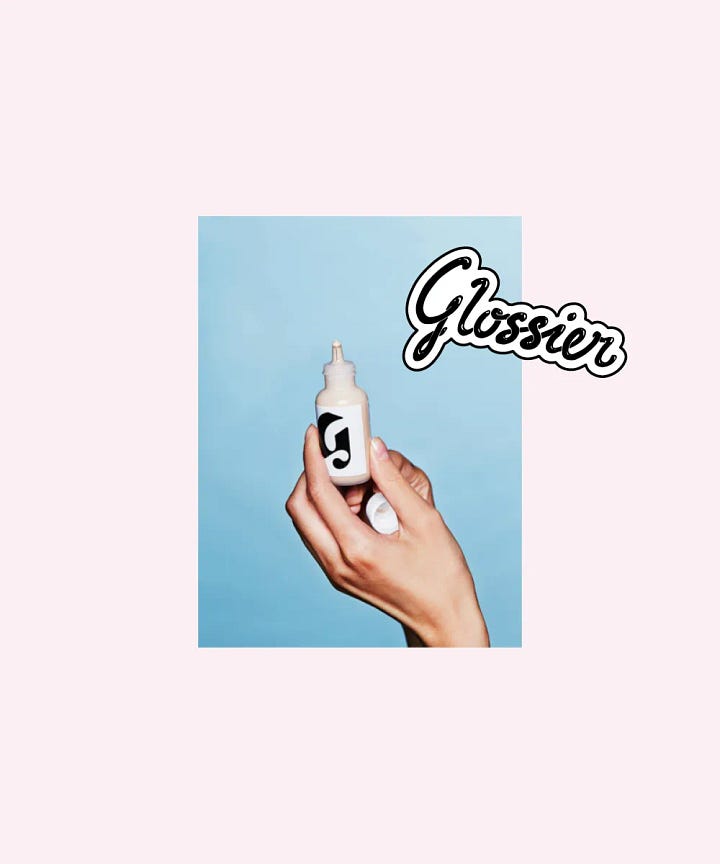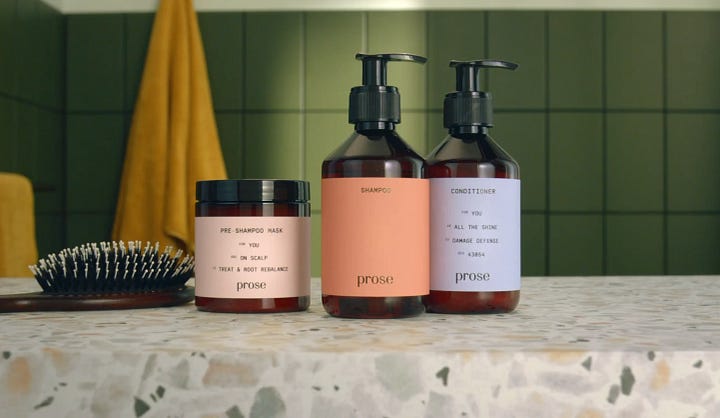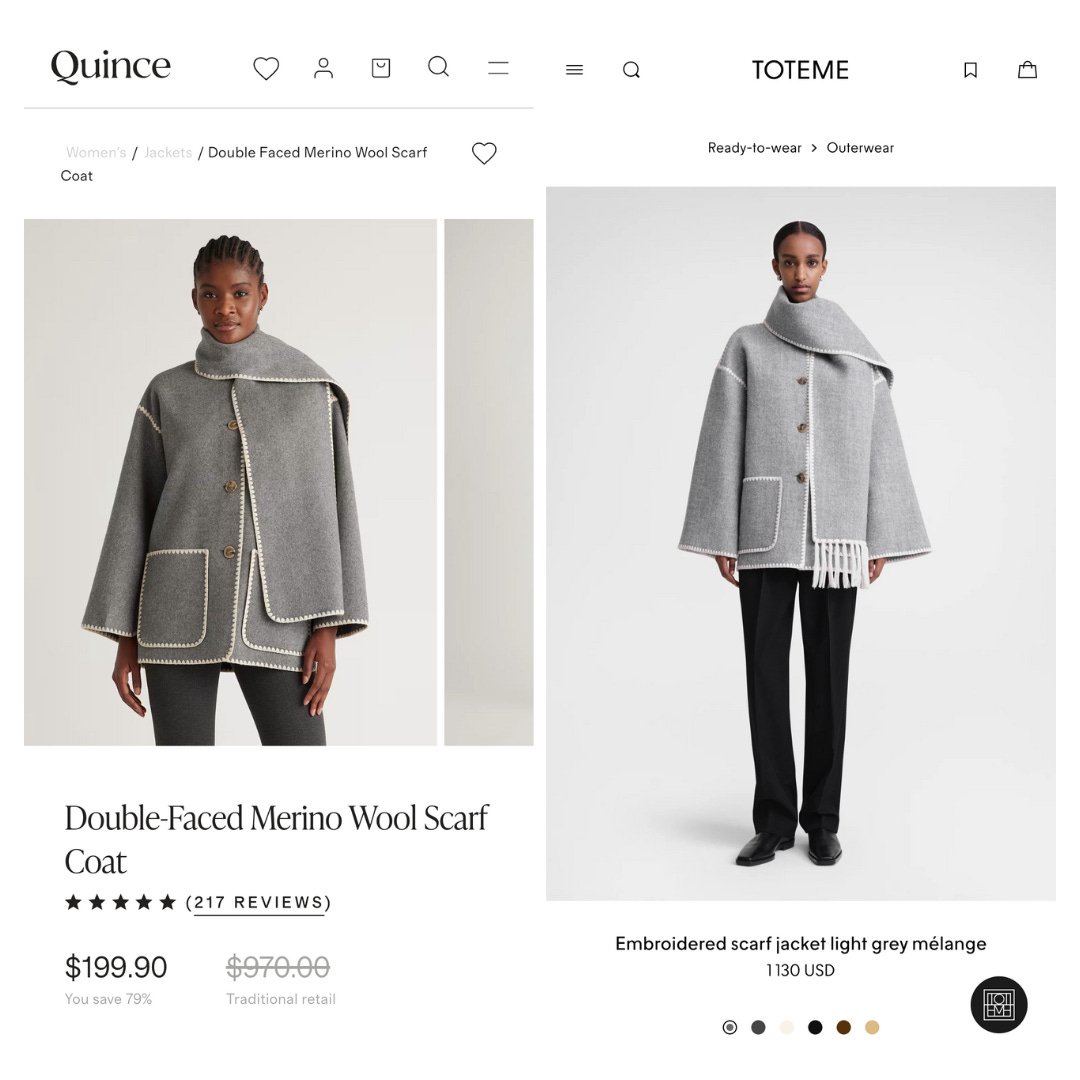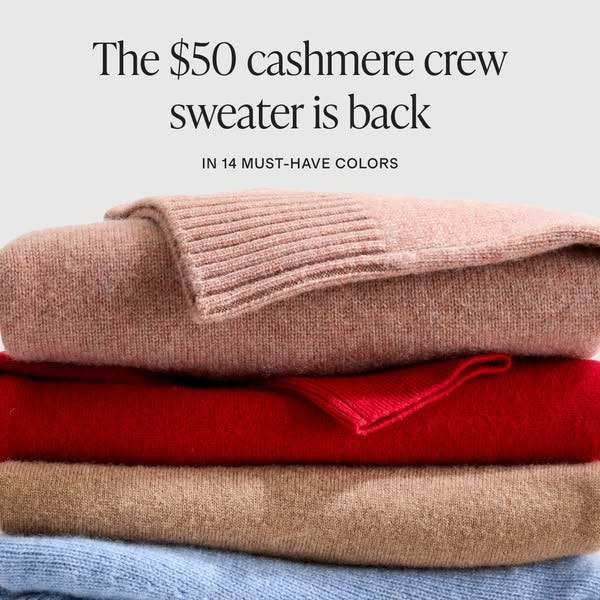Strap in, folks, because this one has been weighing on my heart.
One of my most-asked questions (especially on TikTok): is:
“What do you think about Quince?”
And I get it. Quince’s presence on social media has snowballed into a now-deafening chorus. Plus, they’re marketing straight to the “quality essentials”, “fewer, better” crowd, which is the same kind of shopper who would likely follow my closet content, too.
I am personally quite interested because Quince is messaging some pretty classic 2010s DTC (direct-to-consumer) stuff, preaching the gospel of “cutting out the middleman”.
That 2010s DTC model has been struggling big-time the last few years (since like, 2021/22). Some might even say it’s collapsed. So, it’s weird to see a DTC playbook actually…succeed?
Before we get into my personal opinion of whether I would or wouldn’t shop at Quince, let’s take a look at why they’ve done well as a business.
How is Quince doing so well?
All aboard The Dupe Express!
Quince is fully knocking off other brands’ products, and they aren’t ashamed of it. And in business, that makes all the difference.
Our first-wave DTC friends (think: Allbirds, Glossier, Outdoor Voices, Casper, etc.) were quite precious about their brand identity. The conversation wasn’t just about “disrupting” the industry through a digital-first approach to retail. These founders all spoke about building a lasting, differentiated *brand*. They spent a lot of time and energy (and money!) trying to do that: to create this super secret brand sauce that was uniquely theirs.
What a funny coincidence that they all landed on essentially the same visual branding.




Note: while very easy to dunk on now, this visual herding is not unique to “Millennial” DTC brands. Trends in visual design are a thing, and post-pandemic “Gen Z” brands will look like this in 10 years, too. They kinda do already.
But 10 years later, Quince said “screw that, let’s just do dupes”.
Let’s do dupes, but with a diabolical twist. Typically, when you buy a “dupe”, you’re buying something cheap on purpose. You know that you’re giving up on quality to get a certain design at a low price. But Quince’s message is different. They’re saying:
Oh no, you actually CAN have it all! It’s the product you want, produced at exactly the same factory! The only difference is the label and the much lower price.
Really seductive, right? More than that, it opens them up to a very ripe market segment who maybe thinks that the Wirkin and Shein are a bit icky but also desperately wants to fill their closet with so-called “elevated basics”.
A dupe factory for people who consider themselves above dupes.
The business of dupes
Here’s where we should take a detour into why duping other brand’s products instead of developing your own is so advantageous from a business perspective.
Developing a new product from scratch takes time, money, and talent. Here’s how that generally goes, in an oversimplified way:
A real person comes up with an idea for a new design
That design is prototyped, and detailed technical specifications are prepared
Those technical specifications are sent to a factory (maybe even multiple factories!), and there is back-and-forth about whether the factory can reproduce those specs and where there is or isn’t flexibility in them
The factory produces samples (at a cost!), usually in multiple variations, to illustrate what options they can provide
Those samples are tested, and there is more back-and-forth about what options are preferred and what else should be improved or adjusted
There is almost always at least one more round of sampling, if not many more
Final specifications are agreed upon and the product goes into production
Things can and do fall apart at any step of this process, for many possible complex and nuanced reasons. That’s why to create a final product line, a brand may begin this process for something like double the number of products that they expect to actually make the final cut.
Developing a new product from scratch is always a gamble. You don’t really know what’s going to resonate until it’s out in the world. For every “hit” product, there are ten flops—and you almost never know which is going to be which ahead of time.
So, imagine you are a brand that has gone through all this time and expense to independently develop potentially hundreds of different products. You’ve invested in inventory and marketing to put dozens of them to market in front of your customer. All to finally get to the ONE viral, hit product.
It’s exactly at that point when a business like Quince swoops in and says “YOINK! Thank you very much. That’s mine now”.
Making a business of dupes means that you get to steal someone else’s development and market testing and just skip straight to the part where you profit from proven products. No time, money, talent, or uncertainty required.
I hope I don’t really need to litigate whether or not this practice is business-as-usual for Quince. But just in case, here are just a few examples straight from Quince’s self-titled “Style Gone Viral” page:
Is this legal? Yes.
And as long as Quince’s customers are not only accepting, but (seemingly) ravenously appreciative of the dupe factory approach, then it is a perfectly valid and rational business decision.
If you take their claims at face value that the quality is identical (hold that thought), then this is THE reason why Quince is able to undercut the brands who originally developed their products to offer the “same” thing at a much lower price.
Don’t believe me? Quince says it themselves, pointing first and foremost to “low designs costs” when explaining how they “get their prices so low”.

I guess they saved on proofreading, too.
All-in on influencer marketing
I mentioned at the top that one of the reasons I am asked so much about Quince on social media is that, at this point, they feel omnipresent on social media.
This isn’t an accident. If knocking off other brands’ products is one half of Quince’s business strategy, then I’d say going all-in on influencer marketing is the other half.
Influencer marketing is all about exploiting the unique, close relationship between a content creator and their followers. That’s why it’s a bit ironic that Influencer is a marketing strategy that gains a lot of efficiencies at scale.
Why? Because any individual engagement with an influencer has the potential to be a total home run or a total flop.
On the “home run” side of the spectrum, a brand could gift (i.e., send a free product) to a major influencer who just so happens to actually try the product and love the product! They might then choose to post about that product, creatively executing the post in a way that just absolutely tickles the algorithm’s fancy, and that post goes viral. If the stars align perfectly, a brand could sell hundreds of thousands of dollars in product just for sending out a $50 package. In isolation, it’s a near-infinite return on marketing spend.
On the “flop” side, a brand could spend months negotiating a paid contract (for maybe tens of thousands of dollars!) with an influencer. That influencer may or may not give a shit about the product, and maybe they creatively phone it in that day. The post doesn’t feel authentic, and their followers know it. The algorithm hates it even more. Barely anyone sees the post, and fewer buy the product. In isolation, it’s an infinitely bad return on marketing spend.
That’s why a small-scale influencer program can be risky! Just like with product development, you rarely know which creators will be hits and which will flop until it’s too late. If your budget only covers ten partnerships, the “sample size” you can afford is small. It may go really well, or really poorly, depending on your unique distribution of hits and flops.
Scaling the program up to hundreds or even thousands of influencers smooths out that risk. It makes it much more dependable on an aggregate level.
This seems to me like what Quince has done. They’ve not only cracked influencer marketing, they’ve made the whole operation a machine. They’re sending out a huge amount of product, generating tons of UGC (“user-generated content”), picking up the winning content, and feeding it right back into paid advertising. Constantly. Like, I have to give that team their flowers for just boots-on-the-ground operationalizing the whole thing.
As an example of just one content template they have on repeat…
As posted by the original creator (as a paid placement):
As re-posted to the official Quince account (notice: new music, and ever so slightly recut clips to hit ten seconds versus the original twelve):
Every bone in my body tells me they must be using at least some of this content in whitelisted ads. Whitelisting is when the creator grants Quince permission to run the content as an ad, all through the original creator’s account. In other words, it looks like a normal post from the creator with their account name at the top, their original caption, all the positive comments from their followers…but the only reason you’re seeing it is that Quince paid Instagram to have it algorithmically boosted.
Sadly, I could not source a confirmed example of this. I suspect that the Facebook Ad Library makes whitelisting purposefully hard to find. If anyone knows how to reliably look up whitelisted ads, please let me know.
But what I can see via the Ad Library is that they’ll take clips from videos like this and slice-and-dice them up with their own scripted voiceover and run that as an ad.
I recognize the creator in this ad as the lovely @mademoisellejaime. Jamie-Lee is Australian, and…the voice in this video doesn’t have an Australian accent. Like, at all.
I’m not suggesting that they’ve stolen from Jamie-Lee. It’s almost certainly all above board, that they paid Jamie-Lee for her content and the rights to alter it for advertising. But you can decide whether or not you like this practice as a consumer.
If Quince differs from our classic 2010s DTC brands in their utter shamelessness in duping hero products, the playbook they’re executing in Influencer is pretty classic 2010s DTC. They’re just doing it to the extreme, on a whole new level of scale.
Put together, these are the two things that I think have made them successful, whatever that means these days. All I’ll say is that a $120M Series C with over $350M raised to date is a hell of a lot to live up to.
Would I shop at Quince?
“Okay, but how do you really feel?”
No, I wouldn’t personally shop at Quince. And here’s why:
I distrust venture-funded DTC fashion brands
Sorry! I just do. This is my cross to bear, having been previously employed by one.
Whenever I can so clearly see the DTC playbook of 1. artificially produce social proof and 2. algorithmically boost it through paid ads…I just get the ick.
I know what’s underneath that veneer, and it isn’t typically a brand with a super-rich story and a genuinely amazing product. Or if there ever was one there, it’s long gone and replaced with a brand that is desperately trying to achieve the 100x unicorn tech company returns their VC investors expect.
That’s already a tall order, but especially so when they aren’t a tech company!
Too-good-to-be-true prices for not great quality
Knowing what I do about DTC apparel production, there is just no way (IMHO) that the product is as amazing and high-quality as Quince claims at these prices.
This is an entire article on its own, but let’s just say: new cashmere should never cost $50. There is no amount of “cutting out the middleman” that gets us there. And sure, other products or categories are probably not so extreme. But I cannot trust a company so completely invested in convincing us that this is totally normal and cool.
And while I appreciate Quince for even putting customer reviews on their website, they’re not beating the allegations for me! For every Quince product I’ve ever been marginally tempted by, a quick scroll through the photo reviews gives me paper-thin, pilly, misshapen vibes, and the temptation evaporates.
I’m sorry to be the one to break the news, and I’m sure many will disagree with me, but the quality is just not very good.
Tanner Leatherstein posted a great video just this week examining one of their bags in detail. While the final conclusion was “well, this jacked-up pieced-together leather is actually a decent value for the price” ($150), the way Quince is marketing the bag is shown to be REALLY deceptive.
That’s kind of the whole gig in a nutshell: what you get might be okay quality for the price, but the price is way too low to get the level of quality they’re selling you on. It rubs me entirely the wrong way, because it’s stuff like this that completely warps our perception of quality, nudging the Overton window so far that we start calling things “good” just because they’re better than terrible.
Coming back to the issue of dupes…
While Quince is completely within their legal rights, I just can’t do it. I don’t feel good supporting a company whose business model is centered on knocking off identifiable designs.
Even beyond right or wrong, this approach just doesn’t add up to anything appealing to me. It results in a bland, boring, “elevated essentials” soup where nothing has an identity because there IS no Quince identity. It was all taken from someone else.
It’s all unremarkable. And if you fill your closet with unremarkable things, then more often than not…you will end up feeling unremarkable. It just isn’t solving the problem for me.
What am I supposed to do instead?
First off: I’m not telling you to do anything. If you like Quince, go for it.
But I suspect (and hope) that if you’ve made it this far, it means you are nodding your head along with me at least to some degree. So here’s what I do instead:
Repeat after me: you don’t need it
The first thing to recognize is: you don’t need any of what they’re selling! I feel that “elevated basics” factories like Quince are often driven by a checklist shopping mentality:
“I need to build out my ‘work capsule’”.
“I need to buy more basics made with 100% natural materials”.
“I need a linen dress for summer”.
With that mentality, Quince feels appealing because it is serving up a basic, inoffensive version of what you seek at a very palatable price with free shipping and free returns. They make it easy for you to check the box.
And so when you hear something like “hey! maybe consider not shopping there?” your gut reaction is “okay, well tell me exactly where the hell else am I supposed to find all these things I need!?”
But, what if you didn’t need any of this at all?
I’ve been in that checkbox mentality before, and every time I found that I could have made do perfectly well without any of the things I thought that I “needed”. In fact, rushing to check the box put me in an even worse spot, because now I had committed myself to something that I never really liked all that much in the first place.
The only time I maybe “needed” to add to my wardrobe was when I graduated from college and started my big girl job. But one good pair of trousers and a matching blazer would have done the job just as well (and, probably better!) than the mess of things I rushed out to buy at TJ Maxx and spent the rest of my 20s painfully letting go.
I haven’t ever experienced fast, dramatic body changes, so that’s a personal blind spot. Fair enough. But knowing what I know now, I still think that I’d approach that change from the perspective of “how can I make as few box-checking purchases as possible?”.
I’ve come to my simple truth: there will always be something to buy. You’re not walking around naked, so there’s no need to go fishing to fill a perceived “gap”. The things you really want will always present themselves to you in time. And when that time comes, you’ll wish you hadn’t already spent your money and energy on a bunch of stuff that feels just okay.
Basics are incredibly thriftable
Okay, I’ve put in my requisite “it’s better to buy less!” plea included by law and free of charge with every one of my posts. You still want to know where you could buy the kind of things you can buy at Quince, but better.
Simple pieces like cashmere sweaters, linen shirts, wool coats, and leather jackets are the most thriftable items out there. There’s a reason they’re called “classics”: they’ve been in continuous mass production for your entire life (and then some), which means there are tons just waiting for you on eBay.
Even better: I promise you can find something even better made than Quince for less money by shopping secondhand. My most-favorite 100% cashmere was all bought secondhand, for well under $50. Click to watch the tips I shared in an old video on how exactly to do that.
Additonally…
If you must, buy from someone doing it their own way
And, who is genuinely exciting you in how they’re doing it.
Warning!!! The answer to this is different for every single person. It’s about what excites YOU, not me, okay? That being said and as an example, I personally like what I’m seeing now from Flore Flore, Donni, The Line by K, and Deiji Studios if I were seeking in the realm of “elevated basics”. Which, again, I do not recommend seeking!!!!
Yes, doing it this way will cost you more per piece than Quince. That’s the true price of paying for design and a business that isn’t unfairly running a loss under the subsidy of VC cash.
Think harder, make some choices, and spend the same amount on fewer pieces. Do this, and (IMHO, obviously!) you’ll come out ahead.
And that’s what I think about Quince.











Thank you so much for writing this!! Quince has been giving me an ick ever since it came out and I've never been able to put my finger on why.
Order 1 item from quince last year - until
I placed the order I didn’t realize it was a direct from China company. Quality was ok, but not great. Price was ok but not great.
Overall I came away with the feeling that Quince was/is SHEIN for grownups.